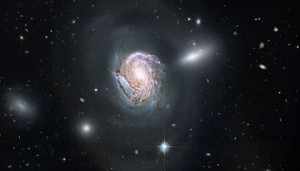High-powered simulations suggest that half of the material in the Milky Way could come from other galaxies.

NASA / ESA / Hubble Heritage Team (STScI / AURA)
Galaxies might look like pristine “island universes,” exchanging stars and gas only when they crash into each other. But real life is messier. Stellar winds and supernovae blow huge amounts of gas out of their host galaxies, some of which rains back down. If launched well enough, though, the gas can escape permanently into intergalactic space, where it may be caught up by other galaxies.
Using the high-definition FIRE simulations, Daniel Anglés-Alcázar (Northwestern University) and colleagues took a closer look at these well-known processes. The team watched the development over cosmic time of multiple systems of galaxies, each with a different kind of galaxy in the middle. FIRE’s superb resolution enabled the team to track gas particles as they flowed here and there in these systems, moving out of, and back into, individual galaxies and between the central galaxy and the ones surrounding it.
Reporting in the October 2017 Monthly Notices of the Royal Astronomical Society, the team found that galaxies are picking up a lot more stuff from other galaxies than previous thought. Previous work had suggested very little of the gas in a Milky Way–mass galaxy would come from other galaxies, maybe 10-20%. FIRE’s numbers are much higher: Somewhere between 20% and 60% of the gas in a modern Milky Way is “intergalactic” — stuff blown out of one galaxy and nabbed by another.
In today’s universe, the team finds, the exchange of gas between galaxies via galactic winds can even be the dominate way a big galaxy acquires material, outstripping in importance the accretion of fresh, unprocessed gas or the recycling of the galaxy’s own outflows. (The latter are more important for dwarf galaxies.)
The simulations also suggest that a Milky Way galaxy permanently chucks out a ton of gas, equivalent to the mass of all the galaxy’s stars — for our galaxy, that’s in the range of 100 billion Suns.
The new result might cause an interesting complication. Astronomers study the history of a galaxy’s different structures and stellar populations using the stars’ compositions: A higher fraction of heavy elements, or metals, generally means the stars formed from gas that’s already been processed by previous generations of stars. But if galaxies are swapping gas, does that undermine astronomers’ study of what’s happening within a galaxy and how it has grown?
Unclear, but probably not. On one hand, intergalactic transfer isn’t as important when a galaxy is first pulling itself together and building things like a spiral disk and central bulge. Plus the metal enrichment that gas undergoes within a galaxy may be far more marked than what it would retain from a previous galactic host. On the other hand, intergalactic transfer or same-galaxy recycling might leave some kind of metallicity fingerprint. If so, the imprint could provide an observational test for these simulations.
Reference: D. Anglés-Alcázar et al. “The Cosmic Baryon Cycle and Galaxy Mass Assembly in the FIRE Simulations.” Monthly Notices of the Royal Astronomical Society. October 2017.
Love astronomy? Dive into the galactic deep with a subscription to Sky & Telescope.
 0
0









Comments
You must be logged in to post a comment.